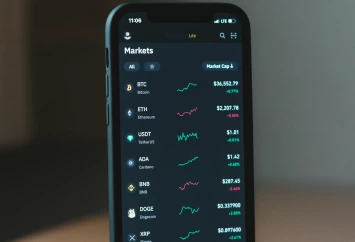Introduction to Cryptocurrency Trading Strategies
Venturing into cryptocurrency trading can be exciting, but understanding the strategies involved is essential for navigating this volatile yet rewarding market. Cryptocurrency trading involves buying, selling, and exchanging digital currencies like Bitcoin, Ethereum, and others through platforms such as Binance or Coinbase. To get started, you’ll need to open an account on a crypto exchange, transfer funds, and begin trading crypto assets.
At its core, cryptocurrency trading aims to generate profit by buying and selling digital currencies. You can trade one cryptocurrency for another or use fiat money for transactions. The market operates on decentralized blockchain technology, which ensures transparency and security in transactions.
Setting up a secure crypto wallet is essential for storing your assets safely. Options include online (hot) wallets or offline (cold) wallets, each offering distinct security advantages.
Successful trading requires understanding market trends, applying tools like technical and fundamental analysis, and managing risks using strategies such as stop-loss orders.
This article explores three popular trading strategies: Day Trading, HODLing, and Swing Trading. Each approach offers unique methods and risk profiles to help you make informed decisions and maximize potential returns in the cryptocurrency market.
1. Day Trading

What is Day Trading?
Day trading is a trading strategy that involves buying and selling financial assets, including cryptocurrencies, within a single trading day. This approach ensures that traders close all their positions before the market closes, avoiding the risks tied to overnight price fluctuations. In cryptocurrency trading, day trading leverages the high volatility and 24/7 market operation of digital assets like Bitcoin, Ethereum, and others.
Unlike long-term investors who hold assets for extended periods, day traders focus on short-term price movements. They rely on various tools and strategies to identify and capitalize on these fluctuations, aiming to profit from the intraday volatility of the cryptocurrency market.
Key Techniques in Day Trading
Day traders use several key techniques to navigate the market effectively. One essential method is technical analysis, which involves studying price patterns, trading volumes, and other market indicators to predict future price movements.
Tools like candlestick charts, trend lines, support and resistance levels, and indicators such as the Relative Strength Index (RSI) and Moving Averages are critical for identifying entry and exit points.
Another technique is news-based trading, where traders monitor economic and political news to anticipate market reactions. This strategy demands quick analysis and decision-making, as news events can significantly impact cryptocurrency prices.
Scalping and swing trading are also popular methods within day trading. Scalping involves executing numerous small trades in a short timeframe, often holding positions for just seconds or minutes.
Swing trading, while typically lasting beyond a single day, can be adapted for day trading by focusing on shorter-term trends and using technical indicators to pinpoint optimal entry and exit points.
Risks and Rewards
Day trading in cryptocurrencies offers both significant rewards and risks. On the reward side, the high volatility of the cryptocurrency market provides numerous opportunities for quick profits.
Traders can benefit from substantial price swings, and leveraging their positions can amplify these gains. Additionally, day trading allows for rapid profits without the long-term holding risks associated with prolonged bear markets.
However, the risks are considerable. Market volatility can lead to rapid price changes, and a single bad trade can result in significant losses. The use of leverage, while boosting potential profits, also increases the risk of liquidation if the market moves unfavorably.
Emotional stress and burnout are common challenges due to the intense focus and constant market monitoring required. Moreover, transaction fees can reduce profits, particularly for frequent traders, and the absence of guaranteed income means even experienced traders can incur losses.
Despite these risks, many traders are drawn to day trading for its potential to deliver rapid growth and for the skills it fosters in risk management, technical analysis, and market psychology.
2. HODLing
Understanding HODLing
HODLing, a term that originated from a typo of “hold” in a 2013 Bitcoin forum post, has become a cornerstone strategy in the cryptocurrency world. Essentially, it is a “buy and hold” approach, where investors purchase cryptocurrencies with the intention of holding them for an extended period, often years, regardless of short-term market fluctuations.
This strategy is built on the belief that the long-term value of these digital assets will appreciate over time.
The core principle of HODLing is to resist the urge to sell during market downturns or surges, maintaining a steadfast commitment to the investment. This approach minimizes emotional decision-making and reduces the risks associated with buying at peak prices and selling at lows.
By holding onto their assets, HODLers aim to capitalize on overall market growth and the potential long-term value appreciation of their cryptocurrencies.
Long-term Investment Perspective
HODLing is inherently a long-term investment strategy. It requires investors to set clear goals and timelines, often spanning several months or years. This involves allocating a portion of the investment portfolio to cryptocurrencies and leaving it untouched for the long haul.
It is essential to invest only the amount of money that can be affordably locked up for an extended period, as this strategy is not suited for those seeking quick liquidity or short-term gains.
The long-term perspective of HODLing also demands patience and resilience in the face of market volatility. This strategy appeals particularly to those who believe in the revolutionary potential of cryptocurrencies and are willing to endure the market’s ups and downs.
By staying committed, HODLers can benefit from the compounding effect of returns over time, potentially leading to significant wealth accumulation.
Considerations and Potentials
While HODLing offers several benefits, it also comes with its own set of considerations and risks. One key benefit is the simplicity of the strategy, requiring minimal involvement and monitoring compared to active trading.
This hands-off approach reduces transaction costs and the stress associated with frequent trading decisions. Additionally, HODLing can provide tax benefits in many jurisdictions, as long-term capital gains are often taxed at a lower rate than short-term gains.
However, HODLing involves significant risks. Market volatility can be challenging to endure, and the value of held assets may drop substantially during bear markets. There is also the risk of asset depreciation if the chosen cryptocurrency fails to gain traction or faces technological or competitive challenges.
Furthermore, the opportunity cost of tying up funds in long-term investments means that HODLers might miss out on other potential investment opportunities.
Despite these risks, many successful HODLers emphasize the importance of thorough research and diversification. Investing in cryptocurrencies with strong fundamentals, a clear use case, and an active development team can increase the chances of long-term success. Diversifying the portfolio across multiple cryptocurrencies helps mitigate risks and maximize potential returns.
By combining careful selection with a patient and disciplined approach, HODLers can navigate the volatile cryptocurrency market with confidence and potentially reap substantial rewards over time.
3. Swing Trading

What is Swing Trading?
Swing trading is a versatile trading strategy that bridges the gap between the fast-paced world of day trading and the long-term commitment of HODLing. This approach involves holding positions for several days to weeks, aiming to capitalize on short- to medium-term price swings in the highly volatile cryptocurrency market.
Unlike day trading, which requires closing all positions within a single day, swing trading allows traders to ride out market fluctuations over a longer period, often resulting in more substantial profits.
Swing trading is particularly suited for cryptocurrencies like Bitcoin and Ethereum, which exhibit frequent and predictable price swings due to their high market volatility. This strategy enables traders to take advantage of these swings by buying at support levels and selling at resistance levels, or by aligning their trades with the dominant market trend.
Strategies and Tools
To succeed in swing trading, traders rely heavily on a combination of technical and, to some extent, fundamental analysis. Technical analysis tools such as trend lines, support and resistance levels, and momentum indicators are essential. For instance, the Relative Strength Index (RSI) and Moving Average Convergence Divergence (MACD) help identify overbought or oversold conditions and potential trend reversals.
Chart patterns like triangles, head-and-shoulders, and flags also provide valuable insights into price movements.
Another effective strategy is the use of the CANSLIM method, which, although typically long-term, can be adapted for swing trading. This involves focusing on cryptocurrencies with strong current performance, annual growth trends, new developments, favorable supply-and-demand dynamics, and significant institutional interest. Additionally, staying updated on market sentiment and trends is essential for making informed trading decisions.
Tools such as technical analysis platforms, cryptocurrency screeners, and risk management tools like stop-loss and take-profit orders are also indispensable. These tools help in identifying trading opportunities, managing risk, and executing trades efficiently. Furthermore, keeping track of market indicators and news can provide additional context for trading decisions.
Managing your crypto portfolio becomes easier with the right cryptocurrency tracking and management tools.
Balance of Risk and Reward
Swing trading offers a balance of risk and reward that makes it appealing to a wide range of traders. On the reward side, swing trading allows for the potential to capture substantial profits from short- to medium-term price swings. This strategy is less stressful compared to day trading, as it does not require constant market monitoring, and it can be managed alongside other commitments.
The use of technical analysis and risk management tools helps simplify the trading process and control potential losses.
However, swing trading also comes with its own set of risks. One of the primary risks is exposure to overnight and weekend market volatility, which can lead to unpredictable losses.
Market reversals can also result in significant losses if not managed properly. Additionally, the need for continuous learning and adaptation to new market conditions and techniques can be challenging and time-consuming.
Despite these risks, swing trading is considered a relatively risk-averse strategy when compared to day trading, thanks to its longer holding periods and the use of robust risk management techniques. By setting clear entry and exit points, using stop-loss orders, and managing the risk/reward ratio effectively, traders can mitigate potential losses and maximize their profits in the volatile cryptocurrency market.
Conclusion
In the ever-changing and unpredictable world of cryptocurrency trading, mastering the right strategies is essential for achieving success. Whether you choose the fast-paced nature of day trading, the moderate-term focus of swing trading, or the long-term commitment of HODLing, each approach demands a solid grasp of market trends, technical analysis, and effective risk management.
Always set clear entry and exit points, diversify your portfolio, and maintain discipline in your trading methods. Prioritize risk management by utilizing tools such as stop-loss orders and adhering to a balanced risk-reward ratio.
By integrating these strategies with ongoing learning and a patient, disciplined mindset, you can confidently navigate the cryptocurrency market and potentially realize significant returns. Take the first step today by selecting a strategy that aligns with your financial goals and risk tolerance, and embark on your journey toward becoming a successful cryptocurrency trader.
FAQ
How do I start crypto trading?
To begin crypto trading, create an account on a reputable crypto exchange platform like Binance, Bybit, or Kraken. Fund your account using methods such as bank transfer, debit card, or wire transfer.
Select a cryptocurrency to trade, such as Bitcoin or Ethereum, and establish a trading strategy (e.g., day trading or swing trading). Ensure you set up a secure wallet and consider using stop-loss orders to mitigate risks.
Stay updated on market news and avoid making decisions based on emotions.
Can you make $100 a day with crypto?
Yes, earning $100 a day through crypto trading is achievable, but it requires effective strategies, diversification, diligent market monitoring, and substantial starting capital. Focus on volatile cryptocurrencies with high trading volumes, apply technical analysis, and prioritize risk management to maintain consistent daily profits.
Is trading crypto a good idea?
Trading cryptocurrency may not be suitable for everyone due to its extreme volatility, vulnerability to hacks and scams, lack of government oversight, and significant environmental impact. While it offers the potential for high returns, it also comes with substantial risks, making it ideal only for individuals with a high risk tolerance.
How profitable is crypto trading?
Crypto trading is highly risky and often unprofitable for the majority of traders. Statistics show that over 70% of traders lose money due to factors like insufficient financial knowledge, high market volatility, poor risk management, and psychological influences such as fear of missing out (FOMO).
Financial Advice Disclaimer:
The information provided in this article is for educational and informational purposes only and should not be construed as financial, investment, or legal advice. Cryptocurrencies are highly volatile and speculative assets, and investing in them carries significant risks, including the potential loss of your entire investment. The content of this article does not constitute a recommendation to buy, sell, or hold any cryptocurrency or financial product.
Always conduct your own thorough research and consult with a qualified financial advisor, tax professional, or legal expert before making any investment decisions. Past performance is not indicative of future results, and the cryptocurrency market is subject to rapid changes, regulatory developments, and technological advancements that may impact the value and viability of digital assets.
The author and publisher of this article are not responsible for any financial losses, damages, or other consequences that may arise from your use of the information provided. Invest at your own risk and only with funds you can afford to lose.


